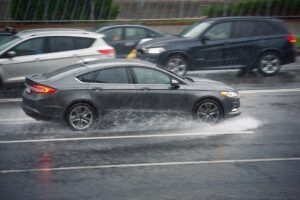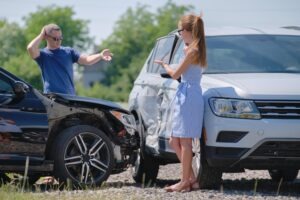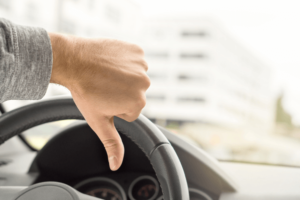
Who has the right of way in a parking lot depends on several factors. Parking lots can be busy and chaotic, with cars coming and going, pedestrians walking between vehicles, and drivers vying for open spaces. Drivers in the main aisles generally have the right of way over those backing out of parking spaces.
This is because drivers in the aisle are already established in the flow of traffic, while those reversing are entering that flow. However, this doesn’t mean that drivers in the aisle are free from responsibility—they must still exercise caution and be prepared to stop for vehicles or pedestrians.
If an accident happens in this situation, determining fault often comes down to whether the driver backing out failed to yield or whether the aisle driver was speeding, distracted, or otherwise negligent. A Fort Lauderdale car accident lawyer can help you file a claim for damages.
General Rules of Parking Lot Right of Way
In most cases, parking lots consist of two types of traffic lanes: main aisles and feeder lanes. Main aisles are the larger lanes that connect directly to entrances, exits, or major areas of the lot, while feeder lanes are smaller lanes leading to individual parking spaces.
Drivers in main aisles typically have the right of way over those exiting feeder lanes or parking spaces, as they are part of the primary flow of traffic. Vehicles in feeder lanes must yield to traffic in the main aisle when merging or crossing. Similarly, drivers exiting parking spots must yield to both feeder-lane and main-aisle traffic.
Parking lots are private property, and while traffic laws provide general guidance, they may not be strictly enforceable unless local ordinances or signage apply. A Fort Lauderdale personal injury lawyer can help prove the negligence of another driver and file your claim.
More people choose The Schiller Kessler Group because they know that we’re a cut above other personal injury law firms.

Responsibilities of Drivers Backing Out
When backing out of a parking space, drivers must proceed with extreme caution and assume responsibility for ensuring the way is clear. Unlike drivers already in motion down an aisle, those reversing are entering the flow of traffic and must yield to any approaching vehicles or pedestrians.
To back out safely:
- Check your surroundings: Look in all directions for oncoming cars, pedestrians, or other hazards. Pay special attention to blind spots.
- Use mirrors and cameras: Backup cameras and mirrors can help provide a clearer view of your surroundings but should not replace physically turning to check for obstacles.
- Reverse slowly: Always back out at a slow, controlled speed to give yourself and others time to react.
In many parking lot accidents, the driver backing out is found at fault because they are entering the traffic flow. However, exceptions can occur if the aisle driver is speeding, distracted, or otherwise negligent.
Responsibilities of Drivers in the Aisle
While drivers in the aisle typically have the right of way over those backing out of spaces, this does not mean they are free from responsibility. Drivers in the aisle must operate with caution and vigilance, as parking lots are high-risk environments for accidents involving other vehicles and pedestrians.
Key responsibilities for aisle drivers include:
- Maintain a safe speed: Parking lots require slow and controlled driving, usually between 5 and 10 mph. Speeding increases the risk of collisions and reduces one’s ability to stop suddenly.
- Stay alert: Watch for reversing vehicles, sudden stops, and pedestrians crossing between cars.
- Yield to pedestrians: Pedestrians always have the right of way in parking lots, whether they are in marked crosswalks or not.
- Avoid distractions: Stay focused on driving and avoid distractions like texting or adjusting your radio.
Even if you have the right of way, you are expected to take reasonable steps to avoid an accident. Failure to do so could result in shared liability if a collision occurs.
Determining Fault in a Parking Lot Accident
Determining fault in a parking lot accident often depends on who failed to yield the right of way. If an accident occurs between a vehicle backing out of a parking space and one traveling down the aisle, the fault is typically assigned to the reversing driver. This is because drivers backing out are legally required to ensure the aisle is clear before entering traffic.
However, there are exceptions. For example, the aisle driver may share or even take full responsibility for the accident if they were:
- Speeding
- Distracted
- Driving the wrong way down a one-way aisle
Similarly, if the reversing driver was halfway out of the space and clearly visible, the aisle driver may be found at fault for failing to stop. If liability is disputed, consulting a lawyer can help you with the process of proving fault and seeking compensation.
Pedestrian Right of Way in Parking Lots
Pedestrians always have the right of way in parking lots, regardless of whether they are using a marked crosswalk. Drivers must remain vigilant for pedestrians, who can emerge from between parked cars or cross unexpectedly at any time.
Key rules for pedestrian safety include:
- Drivers must yield: Always stop for pedestrians walking through the lot, even if they are not in a designated crosswalk.
- Pedestrians should remain alert: While pedestrians have the right of way, they should exercise caution by watching for reversing vehicles or distracted drivers.
- Children and families: Be extra vigilant around children, who may act unpredictably, especially in areas with heavy foot traffic.
In the event of a pedestrian-involved accident, the driver is typically liable unless the pedestrian acts recklessly, such as running into traffic without looking.
We Can Explain More About Who Has the Right of Way in a Parking Lot
Understanding who has the right of way in a parking lot can help you avoid accidents and protect yourself if a collision occurs. Drivers backing out of parking spaces must yield to those traveling in the aisle, but aisle drivers also have a responsibility to drive cautiously and remain alert. By following these guidelines and exercising patience, you can navigate parking lots safely and minimize risks.
If you’ve been involved in a parking lot accident and need help determining liability or pursuing compensation, The Schiller Kessler Group can help. Contact us today for a free consultation.
Injured? Call The Aggressive Attorneys Today





